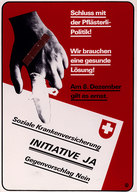
Unternavigation
Health insurance returned at the top of the political agenda in the 1970s. The idea of mandatory insurance coverage was once again a hotly debated topic. This question had been put on the backburner after the rejected tuberculosis bill (1949). The first partial revision of the Health and Accident Insurance Act of 1964 had also been limited to a few adjustments. Debate on reform began at the end of the 1960s due to rapidly growing healthcare costs. As it had been the case in 1964, political parties, trade unions and employers were not the only forces that structured the debate. Above all, it was health funds, medical associations and the pharmaceutical industry that sought to compete with the Federal Council, Parliament and the Federal Social Insurance Office in order to make their voices heard. These complex discussions centered around two fundamental questions: should Switzerland declare health and accident insurance mandatory as other countries did and as the left had been demanding for a long time? Moreover, how should benefits be financed in the future? At the time, the option of financing benefits through payroll contributions was put forward on the table.
On 8th December 1974, voters were asked to choose between three alternatives. First, a popular initiative by the Social Democratic Party called for comprehensive mandatory health insurance (including nursing care, maternity and accident insurance) that was to be funded in part by payroll contributions. Second, a parliamentary counter project backed by the bourgeois parties, business associations, health funds and doctors which did not include an obligation for health care insurance. It did, however, envision a mandatory insurance for inpatient healthcare that would be financed by payroll contributions. As a reference to the 1972 meeting place for experts' commission that had devised this solution, the parliamentary project was dubbed the "Flims Model". Voters then had a third possibility: they could reject both proposals and opt in favor of maintaining the status quo. After a hard-fought referendum campaign, the majority of voters decided to oppose both new options, and thus maintained the status quo. This brought about yet another failed attempt – after 1900 and 1949 – at introducing a (partially) mandatory health insurance. Yet, if the yes votes for both proposals were added together, a majority had indeed wanted to reform health insurance.
Literatur / Bibliographie / Bibliografia / References: Alber Jens, Bernardi-Schenkluhn Brigitte (1992), Westeuropäische Gesundheitssysteme im Vergleich: Bundesrepublik Deutschland, Schweiz, Frankreich, Italien, Grossbritannien, Frankfurt; Sommer Jürg (1978), Das Ringen um die soziale Sicherheit in der Schweiz. Eine politisch-ökonomische Analyse der Ursprünge, Entwicklungen und Perspektiven sozialer Sicherung im Widerstreit zwischen Gruppeninteressen und volkswirtschaftlicher Tragbarkeit, Diessenhofen.
(12/2016)




